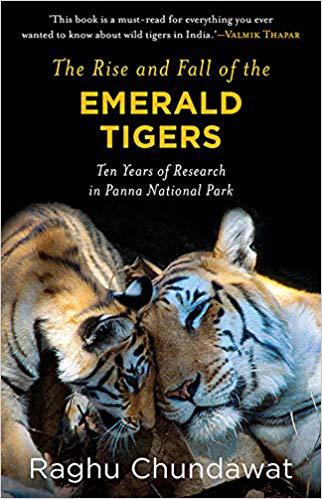Raghu Chundawat, who tracked tigers for eight years in Panna National Park, writes a book on his tryst with the big cat and the forest department. It’s a story of hope, passion, dedication and triumph over adversity
For the first time in India, an expert who has worked with tigers in the field for more than a decade in Panna National Park (PNP), has ventured to write a book. That’s why The Rise and Fall of the Emerald Tigers by Raghu Chundawat stands out. A conservationist biologist, he’s one of the most accomplished tiger experts in the country. Scientific in his approach and a passionate conservationist, he has done extensive field work not just with tigers in Panna but also with snow leopards in the Himalayas.
He and his wife, Joanna Van Gruisen — a photographer of repute — are outspoken wildlife advocates. This book is an informed assessment of tiger conservation in India, culmination of eight years of tracking tigers in the wild, making it the longest study on tigers in India. The scientific research is made accessible in lucid language, which will help readers understand tiger–the species–better and throw light on their ecology.
A prodigy of the Wildlife Institute of India (WII), Raghu decided to study tigers in PNP, a tropical dry forest. During the period of his study, 1996-2001, PNP saw dramatic improvement in the tiger population — from 10-15 tigers the population got more than doubled in six years and reached a figure of 35. Chundawat gives credit to the management of the park under the then director, PK Chawdhry, who opened the door for research.
Many accomplished environmentalists, who partnered in PNP in those years, helped in the better management of the park that resulted in a dramatic rise in the tiger population. Chundawat collared as many as five tigers and over the years, was able to create a reliable prey monitoring system. He became the blue-eyed boy of the forest department and was encouraged to undertake similar studies in other tiger reserves.
In the process, he and Joanna, were also able to create a personal bonding with some tigers. “I could no longer be a dispassionate scientist, as we are told to be,” he writes. Tigers were part of his family. He mentions the matriarch of the Panna tigers, who was called ‘Baavan’, which means fifty-two in Hindi.
Baavan was resilient and survived the phase after 2001, when most of tigers in Panna were lost . “We also learned how resilient, temperamental, trusting and–contrary to the popular perception—peaceful, these creatures are,” writes Raghu, expressing his love and passion for the biggest cat in the world.
PNP had become a role model for the rest of the world as to how science and management can work together to bring great success. But this was not to last long, the best phase in the history of the park, was followed by the worst. The new director, Sanjay Mukhariya, was not so accommodating as far as the research activities were concerned. He began creating hurdles. Elephants were made available to tourists, instead of field work. Subsequently, researchers were also banned from entering the park in the night.
Raghu was not just a plain researcher, he was eyes and ears in the forest. While his access was curtailed, and poachers felt encouraged to enter the park. He reported that many snares were recovered in the forest, indicative of the growing poaching activities. He also reported missing tigers. But Mukhariya wasn’t interested.
The first tiger went missing in October 2002. Between November 2003 and February 2004, Raghu documented 15 animals killed with the use of noose or trap. Tigers were disappearing fast and Mukhariya was still in denial.
![]()
As per the book, Chundawat met Rajesh Gopal, the then Director-Project Tiger, and informed him of the state of affairs in PNP. The latter was affable, but Raghu realised the hard way that it was a mistake to approach him. In February 2004, his equipment and jeep were seized by the forest department, and was only released after the intervention of the Chief Wild Life Warden of Madhya Pradesh (MP). But only after imposing debilitating restrictions. The message was clear — researchers are not allowed inside the park. Instead of investigating the growing instances of poaching, the forest department focused their energies on discrediting Raghu and his project.
The forest department falsified evidence at ground to paint a rosy picture. The book details how in 2005, the forest department tried to fudge figures by carrying out faulty tiger census. Chundawat was opposed to all such moves, but there was no taker. However, the Central Empowered Committee (CEC) of the Supreme Court in its report in February 2005, stated, ‘Panna is showing signs of Sariska.’
In Sariska, tiger reserves were emptied of all 18 tigers by poachers, while the forest department remained in denial till a CBI enquiry established the grim reality in March 2005. Similarly, PNP had lost nine of its 11 known breeding tigers in the last two and a half years since 2002.
The policy adopted by the forest department of MP was to shoot the messenger and ignore the message. Chundawat was in the eye of the storm. He was dubbed as ‘anti-establishment’ because he received support from foreign agencies for his research.
His land purchase and shooting of a BBC documentary between 2002 and 2003, was investigated. The Subsidiary Intelligence Bureau of the state questioned him, hinting his possible connivance in tiger poaching. His project was suspended in May 2004. In an affidavit filed to the apex court, the MP forest department, instead of dealing with the issue of the disappearance of tigers, accused Raghu of ‘deep financial interest’ and ‘certain violations and grave negligence’.
In 2006, WII conducted a pan-India tiger assessment using camera-trap method, which included PNP. “The data from WII report supported our contentions but the covering letter from the Director (of WII) gave a completely contrary picture,” writes Raghu, which stated ‘a healthy tiger population in the study area.’
“It was galling,” Raghu was appalled by volte-face, the same report was used a year later in 2009 by Rajesh Gopal to confirm the worst fears. “Panna, along with Sariska Tiger Reserve, exemplifies… isolated tiger population to local extinctions caused by poaching, even in areas with suitable habitat and sufficient prey,” wrote Rajesh Gopal in Oryx, the International Journal of Conservation.
Needless to add, neither the forest officials deployed at Sariska or Panna, who presided over the extinction of tigers, were ever held responsible. It might as well be the story in other parks and tiger reserves, who knows? And those who are supposed to know are known to be in perpetual denial, they never own up to their responsibility. This book narrates the sordid realities of tiger conservation in India.
The forest department has the exclusive right to manage the wildlife sanctuaries and parks, which has an advantage and disadvantage as well. A good official can single-handedly destroy, or for that matter, restore the park. The current management of PNP is an efficient one, and the results are for everyone to see. A healthy population of 30 tigers resides in PNP after the successful relocation of four female and a male tiger in 2009.
Chundawat is of the view that we should protect tigers and not tigers inside the protected areas, as there’s a need for a more inclusive conservation model where local communities and the public at large become partners in the conservation effort.
This book is a must read for those who love tigers, wildlife and nature in its full glory.





